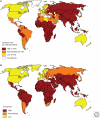The hygiene hypothesis: an explanation for the increased frequency of insulin-dependent diabetes
- PMID: 22355800
- PMCID: PMC3281594
- DOI: 10.1101/cshperspect.a007799
The hygiene hypothesis: an explanation for the increased frequency of insulin-dependent diabetes
Abstract
The steadily increasing frequency of insulin-dependent diabetes in several countries is best explained today by the decline of infections. Epidemiologic and animal data support this conclusion, which, however, requires confirmation by intervention trials in man. The mechanisms of the protective effect of infections on diabetes onset are diverse including competition for homeostatic factors and stimulation of regulatory T cells and of Toll-like receptors. These considerations might have interesting therapeutic applications for the prevention of the disease.
Figures


References
-
- Adorini L 2004. Tolerogenic dendritic cells induced by vitamin D receptor ligands enhance regulatory T cells inhibiting allograft rejection and autoimmune diseases. Kidney Int 65: 1538 - PubMed
-
- Airaghi L, Tedeschi A 2006. Negative association between occurrence of type 1 diabetes and tuberculosis incidence at population level. Acta Diabetol 43: 43–45 - PubMed
-
- Allen HF, Klingensmith GJ, Jensen P, Simoes E, Hayward A, Chase HP 1999. Effect of Bacillus Calmette-Guerin vaccination on new-onset type 1 diabetes. A randomized clinical study. Diabetes Care 22: 1703–1707 - PubMed
-
- Alyanakian MA, Grela F, Aumeunier A, Chiavaroli C, Gouarin C, Bardel E, Normier G, Chatenoud L, Thieblemont N, Bach JF 2006. Transforming growth factor-β and natural killer T-cells are involved in the protective effect of a bacterial extract on type 1 diabetes. Diabetes 55: 179–185 - PubMed
-
- Ascherio A, Munger K 2008. Epidemiology of multiple sclerosis: From risk factors to prevention. Semin Neurol 28: 17–28 - PubMed
Publication types
MeSH terms
Substances
LinkOut - more resources
Full Text Sources
Other Literature Sources
Medical
